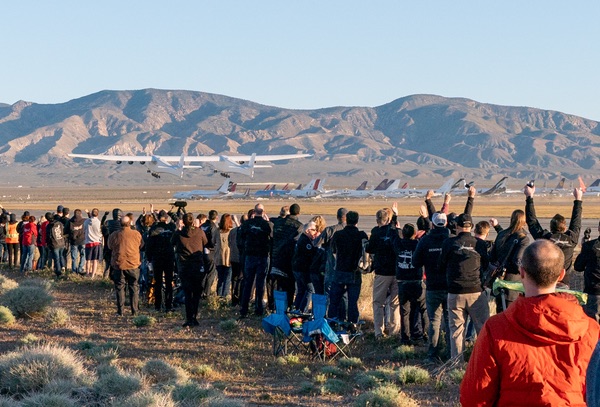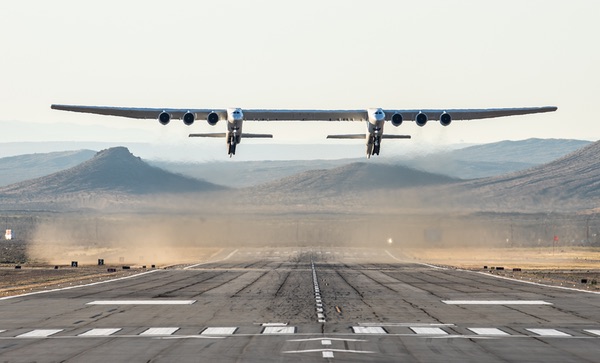Delayed takeoffby Jeff Foust
|
| “I honestly could not have hoped for more on a first flight, especially of an airplane of this complexity and this uniqueness,” Thomas said. |
For two and a half hours the plane flew above the airport and surrounding airspace, reaching a peak altitude of more than 5,000 meters and top speed of about 300 kilometers per hour. The plane then returned to the airport, making one low approach before circling around and touching down on the runway.
Thomas and Stratolaunch officials played up the successful technical aspects of the flight in a brief call with reporters shortly after landing. “The flight itself was smooth, which is exactly what you want a first flight to be,” Thomas said. “For the most part, the airplane flew as predicted.”
He noted that he noted “a few little things that were off-nominal” in the flight, but didn’t specify what they were. Overall, though, the plane handed in flight much as expected, he said. “I honestly could not have hoped for more on a first flight, especially of an airplane of this complexity and this uniqueness.”
“Overall, we’re very pleased with how the Stratolaunch aircraft performed,” said Zachary Krevor, vice president of engineering at Stratolaunch. “The flight really went great.”
New aircraft making their first flight don’t normally get this level of attention, but most new aircraft are nothing like Stratolaunch’s plane. The giant aircraft features twin fuselages, six jet engines, and a 117-meter-long wing that makes the plane the largest in the world by wingspan. Nothing quite like it had ever flown before.
“It was an emotional moment for me to personally watch this majestic bird take flight, to see Paul Allen’s dream come to life in front of my very eyes,” Jean Floyd, CEO of Stratolaunch, said. “I had imagined this moment for years.”
 Onlookers cheer the takeoff of Stratolaunch’s plane. (credit: Stratolaunch) |
He imagined that moment for years in part because that first flight was supposed to have taken place years ago. When Allen announced plans for Stratolaunch in late 2011, he expected the first flight of the aircraft to take place in 2015, with launches using the aircraft set to begin in 2016 (see “Stratolaunch: SpaceShipThree or Space Goose?”, The Space Review, December 19, 2011).
It’s probably not surprising that development of the plane took longer than expected, given that such delays are commonplace in large aerospace programs. But Stratolaunch has seen a far less common degree of upheaval and change since that December 2011 press conference.
| Stratolaunch has seen a far less common degree of upheaval and change since that December 2011 press conference. |
Originally, Stratolaunch was going to fly a derivative of SpaceX’s Falcon 9, with four or five engines, rather than nine, in the first stage. That partnership, which included having SpaceX president Gwynne Shotwell on the board of Stratolaunch, always looked a little odd: why would SpaceX supply a launch vehicle to a would-be competitor? It was not surprising, then, when SpaceX and Stratolaunch parted ways within a year of the announcement.
Stratolaunch then turned to Orbital Sciences Corp. (later Orbital ATK and now Northrop Grumman Innovation Systems) to develop another medium-class launch vehicle. The Thunderbolt rocket would have used solid-fuel lower stages from ATK and an upper stage powered by an RL10 engine from Aerojet Rocketdyne. In 2014, around the time Stratolaunch unveiled the Thunderbolt vehicle, the company was projecting a first launch of the vehicle in 2018 (see “Air launch, big and small”, The Space Review, June 30, 2014).
Two years later, the situation had changed. Thunderbolt was out as Stratolaunch looked to growing demand for small satellites, which could more effectively use smaller rockets. The company was considering what it said at the time was as many as 70 different vehicle configurations that could serve the smallsat market (see “Inside Stratolaunch”, The Space Review, June 20, 2016).
Eventually it went back to what was then called Orbital ATK, but for something far smaller: the venerable Pegasus XL, which had been launching smallsats from the company’s own L-1011 aircraft since the 1990s. The company said that Stratolaunch’s plane could carry as many as three Pegasus XL rockets on a single flight, launched at different times to different inclinations.
However, Stratolaunch was also working on its own launch vehicle plans. In 2017, the company signed a Space Act Agreement with NASA to perform engine tests at the Stennis Space Center, while hiring a former SpaceX propulsion executive, Jeff Thornburg. The company said little publicly about its plans until last August, when it announced it was developing its own vehicles. One, simple called the Medium Launch Vehicle, would place up to 3,400 kilograms into orbit, while the Medium Launch Vehicle – Heavy, with three first stage booster cores, would place up to 6,000 kilograms into orbit. The company also said it was studying a “fully reusable space plane” that would launch cargo, and eventually people, harkening back to earlier studies it performed with Sierra Nevada Corporation about using a version of that company’s Dream Chaser.
A month later, it disclosed details on the engine it was developing, called PGA, the initials of company founder Paul G. Allen. When completed, PGA would produce 200,000 pounds-force of thrust and have the highest specific impulse of any such engine, although it didn’t disclose a specific value.
| “We are streamlining operations, focusing on the aircraft and our ability to support a demonstration launch of the Northrop Grumman Pegasus XL air-launch vehicle,” a company spokesman said in January. |
Those plans, though, changed after the death in October of Allen of non-Hodgkin’s lymphoma. Vulcan, the holding company for Allen’s various ventures, including Stratolaunch, said immediately after Allen’s passing that there were plans in place to address those efforts, but would not disclose them beyond saying no immediate changes were planned.
Changes, though, started in January. A little more than a week after the final high-speed taxi test of Stratolaunch’s plane in Mojave, the company disbanded its propulsion team and halted work on the engine and its family of launch vehicles. “We are streamlining operations, focusing on the aircraft and our ability to support a demonstration launch of the Northrop Grumman Pegasus XL air-launch vehicle,” a company spokesman said in a statement.
The company hasn’t elaborated on its strategy since that January announcement. During the brief call with reporters, executives said nothing about the company’s future plans, including when—or even if—the plane will fly again. They took no questions during the call that lasted barely ten minutes.
Relying on the Pegasus XL does have the advantage of not requiring the company—likely through Allen’s estate—to spend tens to hundreds of millions of dollars on a rocket like the Medium Launch Vehicle and its engine. That’s on top of the hundreds of millions already spent on its one-of-a-kind plane.
But the disadvantage is that the Pegasus XL has failed to find much business in recent years despite the growth in interest in small satellites that has spurred the development of dozens of new small launch vehicles. Cost is a big factor: NASA announced in 2014 it would spend $56.3 million on the Pegasus XL launch of the Ionospheric Connection Explorer (ICON) satellite. That’s a tough price to swallow for many, given cheaper launch options, including rideshare opportunities on larger rockets.
As a result, NASA has been the only customer for the Pegasus XL in recent years. And despite its heritage, including a track record of dozens of consecutive successful launches, it’s had its problems as well. That ICON mission, once scheduled for mid-2017, has yet to launch because of technical problems. At a February meeting of an advisory committee, a NASA official said they agency hopes to launch that mission some time in the second quarter, but no date has been set. No other missions are currently on the Pegasus XL manifest.
While Stratolaunch executives have previously argued that it could carry out national security missions in a responsive manner, including the ability to deploy a constellation on a single flight by launching three Pegasus rockets on varying trajectories, the military is keeping other options open for responsive launches of smallsats. DARPA used Rocket Lab’s Electron rocket to launch a technology demonstration satellite last month, and Electron’s next mission later this month will carry three smallsats for the Air Force.
| “Even though he wasn’t there today,” Floyd said, “as the plane lifted gracefully from the runway, I did whisper a thank-you to Paul for allowing me to be a part of this remarkable achievement.” |
Last week, DARPA announced its selection of three qualifiers for its DARPA Launch Challenge competition. Vector, Virgin Orbit, and an unidentified company in stealth mode (thought by some in the industry to be Astra Space) will carry out two launches from two different launch sites on short notice in early 2020. Each company will get $2 million if the first launch is successful, and will be eligible for prizes from $8 to 10 million if they carry out the second launch.
During that seven-plus years between the announcement of Stratolaunch and the plane’s first flight, a lot of has changed in the space industry, including a shift to smaller satellites that make that plane oversized (and probably too expensive) to effectively serve. By comparison, Virgin Orbit’s air launch system uses a modified Boeing 747—after initially considering using the same WhiteKnightTwo used by the SpaceShipTwo suborbital spaceplane—that was likely far less expensive to acquire and modify.
As long as Paul Allen supported the company, though, the company could weather those changes in the market, and changes in its business plan. “His vision is to change the human condition,” Floyd said of Allen during a panel discussion in 2017. “He’s not out to make a buck. He’s not out to get a return on investment.”
“I’m not saying he wants to lose money,” he added. “But Paul Allen has never talked to me about, ‘How much money am I going to make if I pull this off?’” With Allen no longer with us, though, such questions likely have been asked, and answered, explaining the decision to drop launch vehicle development.
Floyd didn’t discuss the company’s future in the call with reporters, but did acknowledge the absence of the man who got Stratolaunch off the ground. “I never imagined the experience without Paul standing next to me,” he said of watching the plane take off. “Even though he wasn’t there today, as the plane lifted gracefully from the runway, I did whisper a thank-you to Paul for allowing me to be a part of this remarkable achievement.”
Note: we are temporarily moderating all comments subcommitted to deal with a surge in spam.
